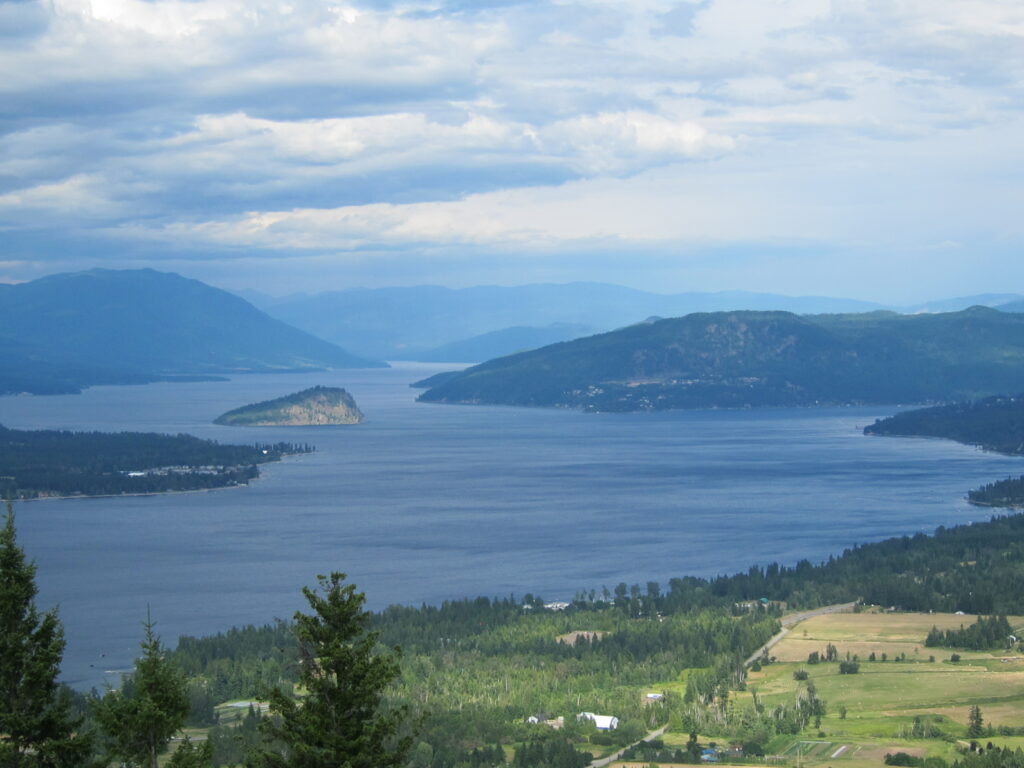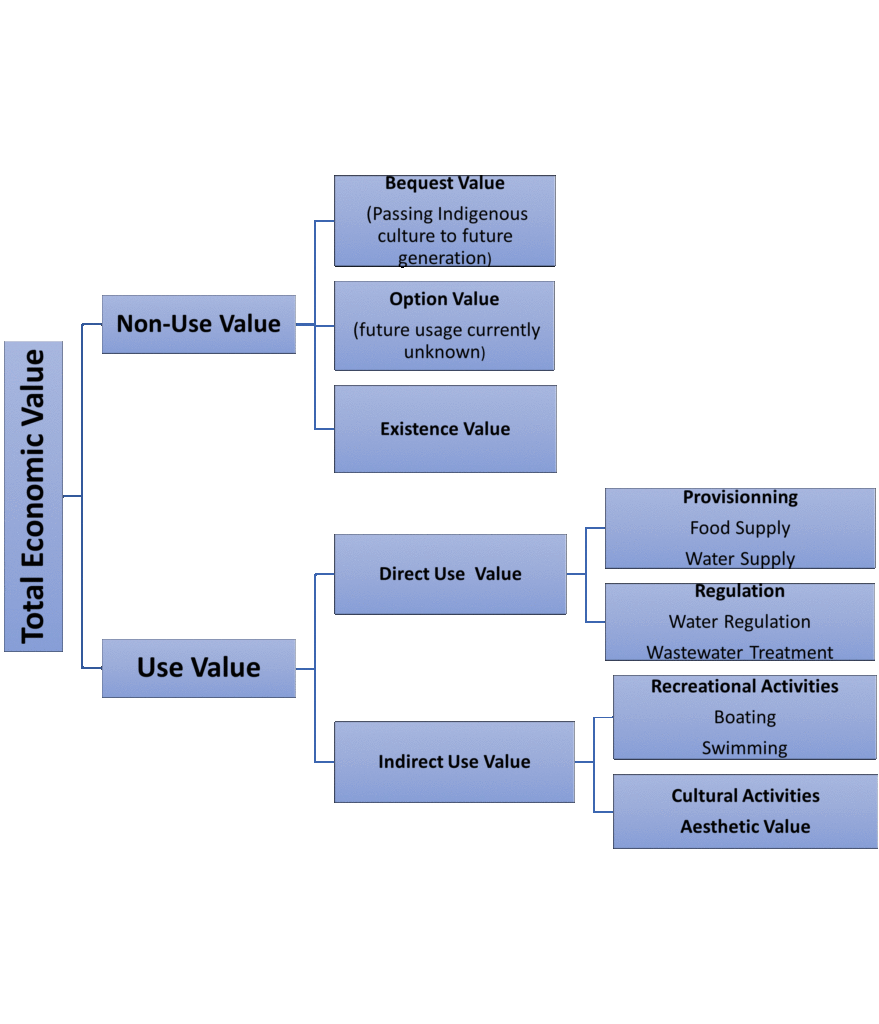12 Shuswap Lake
Gisele Shema
About Shuswap Lake
Shuswap Lake is a lake situated in the Shuswap region, British Columbia. It is named after the Shuswap people of the Interior Salish band, and the name may be derived from “sixwt”, meaning downriver (Akrigg & Akrigg, 1997). The region around the lake is home to the Little Shuswap Indian Band and the Adams Lake Indian Band, which are the First Nations band government of the communities of the Secwépemc (Adams Lake Indian Band, n.d.; British Columbia Assembly of First Nations, n.d.b).
Shuswap Lake is located approximately 347 m above sea level, and it forms an atypical H shape comprised of four long protrusions called Salmon Arm, Main Arm, Anstey Arm, and Seymour Arm (Ministry of Environment and Climate Change Strategy, 2022). The lake has an average depth of 62 m, a perimeter of 342 km, a surface area of 310 km2, and a volume of 19 km3. The Shuswap Lake has three relatively large drainage sources (Adams, Mabel, and Sugar Lakes) and flows into Little Shuswap Lake via the Little River from the Main Arm.
Ecosystem Services
Shuswap Lake offers many ecosystem services. The lake serves as a cultural and spiritual place for the Salish people, who live in the region, offers recreational activities (and park services), and serves as a water and food supply for the locals (Ministry of Environment and Climate Change Strategy, 2022). The city of Chase also uses the lake for water regulation and wastewater treatment. Those who use the lake for recreational purposes can enjoy many activities, including boating, fishing, canoeing, kayaking, swimming, whitewater rafting, birdwatching, and camping, along the many provincial parks on the lake shore. Shuswap Lake is part of the salmon life cycle that supplies the lakes in the regions with sockeye salmons as it serves as their home for the first year of life (Fisheries and Oceans Canada, 2019).
Potential Ecological Issues
In the news, Kamloops This Week (2020b) reported that an invasive species of Asian clam has been found in Shuswap Lake. Those clams can potentially impact the safe usage of the lake ecosystem services, mainly boat maintenance and fish abundance in the lake. Additionally, Wickett (2022b) reported the effect of climate change on the lake and the prevention of salmon spawning that was caused by low water levels. Furthermore, Wicket (2022a) reported an emerging algae bloom in Shuswap Lake that resulted in drinking water advisory and suspension of activities such as swimming and a high level of E. coli that was found in the water sample near Sunnybrae Beach.

Valuation of Shuswap Lake
Shuswap Lake provides us with ecosystem services that are unique and beneficial to humans. However, since lakes are common goods, Shuswap Lake may be subject to overexploitation and misuse, resulting in deterioration. Salles (2011) argues that “there is then a need, like for many assets involving public good aspects, to implement public policies based on efficiency considerations. In this perspective, evaluating ecosystems to improve information for decision-making has been repeatedly proposed.” Valuation of ecosystem services provided by Shuswap Lake is important because it helps the users to understand its value, which is needed to develop systems to use it efficiently. This valuation will hopefully steer efforts toward conservation.
Total Economic Valuation
Patterson and Cole (2013) argue that the “TEV (Total Economic Valuation) of ecosystems, like any resource, consists of use value and non-use (passive) value. The passive-value component can be subdivided into option, bequest, and existence-value components.” Shuswap Lake will probably derive most of its value from use values through many of its ecosystem services, especially recreation activities and from the non-use value of bequest for the Indigenous people who champion its conservation for the next generations. Additionally, the value of Shuswap Lake will be derived from areas outside the economic evaluation, such as nonmaterial human-nature connections (Gould & Schultz, 2021).
Figure 2 details the total economic value of Shuswap Lake in relation to the different values.

Methodology: Benefit Transfer Method
Many valuation methods exist, such as contingent valuation, market price, travel cost, choice experiments, replacement cost, and factor income methods, that can be used to estimate the value of ecosystem services. This chapter will use the benefit transfer method (BTM) to estimate the value of ecosystem services provided by Shuswap Lake.
Plummer (2009) defines the BTM as a technique that estimates the total economic value of one site by using the value from another site called the study site. BTM allows using previously gathered information about the cost per hectare of other lakes and applying the value to Shuswap Lake. The advantage of using BTM is the availability of data for the estimated value of different lakes and the feasibility when there is a limited budget.
With the BTM, the value of Shuswap Lake, which has a total area of 31,000 ha, will be estimated using the range of values with a low of $23,542 and a high of $78,804 per hectare for lakes in the countries mentioned above. Additionally, this chapter will use the discount rates of 3%, 1.5%, and 0.1% to estimate the lake’s intrinsic value. Many valuation studies about the environment usually use a high discount rate of 3%; however, lower discount rates are usually advised when environmental damages are of concern and when considering the future generation’s benefits.
Table 1 shows the yearly and intrinsic asset value of Shuswap Lake using 3.0% and 0.01% discount rates.
Table 1: Shuswap Lake Yearly & Intrinsic Asset Value
| Skip Table 1 | ||||
| Value Type | Yearly Value (in millions of USD) | Intrinsic Asset Value – 3.0% (in billions of USD) | Intrinsic Asset Value – 1.5% (in billions of USD) | Intrinsic Asset Value – 0.01% (in billions of USD) |
|---|---|---|---|---|
| Lowest Value | 729.8 | 24 | 49 | 730 |
| Highest Value | 2,443 | 81 | 163 | 2,443 |
Shuswap Lake has a yearly value ranging from $729.8 million to $2.44 billion, and its intrinsic value ranges from $24.3 billion (high discount) to $2.4 trillion (low discount). As such, the lake holds almost the same value as all the private property in British Columbia, which the Land Title and Survey Authority of British Columbia (n.d.) assessed at $2.72 trillion as of January 2023. The revelation indicates that the lake is an important element of those who use all its services, and thus, it should be properly managed and protected to ensure that it is used efficiently.
Concluding Remarks
Shuswap Lake’s yearly value indicates that it is significant to those living in the region and beyond. The lake offers many valuable ecosystem services that are important to humans. It is one of the most important recreational spaces to carry activities such as swimming, boating, and kayaking in the region for residents of Salmon Arm, Chase, and other communities. Climate change has started to impact the lake negatively and may further lead to the loss of some ecosystem services such as food supply and water supply. It is imperative that all stakeholders invest in sustainable usage and prioritize its conservation to ensure that all ecosystem services remain uninterrupted.
In the newsletter issued in March 2023, Joyce Kenoras, one of the chiefs at the Adams Lake Indian band, said, “In our role as stewards of Timcw and Sawllkwe, we must pay close attention to wastewater and how we mitigate risk and impact to our land. We must use a blend of science and technology to advance and preserve water and land in Secwépemculecw” (Kenoras, 2023). Technology has evolved to help people access the different ecosystem services provided by Shuswap Lake, and it can be used further to ensure the lake is used efficiently by all the stakeholders: the government, the private sector, and the public. It is of the utmost importance that natural assets are protected because they provide us with services that lack substitution and, thus, must be preserved for future generations.
Media Attributions
Figure 1: “ShuswapLake” by The Interior (2014), via Wikimedia Commons, is used under a CC BY-SA 4.0 license.
Figure 2: “Breakdown of Shuswap Lake’s total economic value” by the author is under a CC BY-NC-SA 4.0 license.
References
Adams Lake Indian Band. (n.d.). Home. https://adamslakeband.org/
Akrigg, G. P. V., & Akrigg, H. (1997). British Columbia place names (3rd ed.). UBC Press.
British Columbia Assembly of First Nations. (n.d.b). Skwlax te Secwepemculecw. https://www.bcafn.ca/first-nations-bc/thompson-okanagan/skwlax-te-secwepemculecw
Fisheries and Oceans Canada. (2019, February). Lifecycle of the Adams River sockeye [Infographic]. Government of Canada. https://www.dfo-mpo.gc.ca/about-notre-sujet/publications/infographics-infographies/sockeye-saumonrouge-eng.html
Gould, R. K., & Schultz, P. W. (2021). Challenges to understanding nonmaterial dimensions of human-nature connections, and how to address them. Ecology & Society, 26(3), 549–558. https://doi.org/10.5751/ES-12604-260314
Kamloops This Week. (2020b, September 21). Warning issued after Asian clams found in Shuswap Lake. https://archive.kamloopsthisweek.com/2020/09/21/warning-issued-after-asian-clams-found-in-shuswap-lake/
Kenoras, J. (2023, March 31). Cstélnec newsletter, 4. https://drive.google.com/file/d/1VncA_wdt_QNynKu38aOs0SVHVptodz4U/view
Land Title and Survey Authority of British Columbia. (n.d.). BC real estate facts. https://ltsa.ca/about-ltsa/ltsa-mandate/bc-real-estate-facts/#
Ministry of Environment and Climate Change Strategy. (2022). Water quality assessment for Shuswap Lake. Environmental Quality Series. Government of British Columbia. https://www2.gov.bc.ca/assets/gov/environment/air-land-water/water/waterquality/monitoring-water-quality/thompson-okanagan-wq-docs/shuswap_water_quality_assessment.pdf
Patterson, M. G., & Cole, A. O. (2013). ‘Total economic value’ of New Zealand’s land-based ecosystems and their services. In J. R. Dymond (Ed.), Ecosystem services in New Zealand: Conditions and trends. Manaaki Whenua Press. https://doi.org/10.7931/DL1MS3
Plummer, M. L. (2009). Assessing benefit transfer for the valuation of ecosystem services. Frontiers in Ecology and the Environment, 7(1), 38–45. https://doi.org/10.1890/080091
Salles, J. (2011). Valuing biodiversity and ecosystem services: Why put economic values on Nature? Comptes Rendus Biologies, 334(5–6), 469–482. https://doi.org/10.1016/j.crvi.2011.03.008
The Interior. (2014). ShuswapLake [Image]. Wikimedia Commons. https://commons.wikimedia.org/wiki/File:ShuswapLake.JPG
Wickett, M. (2022a, June 28). ‘Emerging algal bloom’ reported on Shuswap Lake. Salmon Arm Observer. https://www.saobserver.net/news/emerging-algal-bloom-reported-on-shuswap-lake-3746807
Wickett, M. (2022b, June 29). Shuswap Lake seeing high E. coli count at Sunnybrae Beach, also emerging algae bloom. Salmon Arm Observer. https://www.saobserver.net/news/shuswap-lake-seeing-high-e-coli-count-at-sunnybrae-beach-also-emerging-algae-bloom-3746856
Wilson, C. (2022, October 5). Low water levels caused by drought preventing B.C. salmon from spawning. Vancouver Sun. https://vancouversun.com/news/local-news/low-water-levels-caused-by-drought-preventing-b-c-salmon-from-spawning
Long Descriptions
Figure 2 Long Description: A sideways tree diagram breaks down the total economic value of Shuswap Lake. Starting on the left side, Total Economic Value is broken down into Non-Use Value and Use Value. Non-Use Value is divided into Bequest Value (passing Indigenous culture to future generation), Option Value (future usage currently unknown), and Existence Value. Use Value is divided into Direct Use Value and Indirect Use Value. For Direct Use Value, it is broken down into Provisioning (e.g., food supply and water supply) and Regulation (e.g., water regulation and wastewater treatment). For Indirect Use Value, it is broken down into Recreational Activities (e.g., boating and swimming) and Cultural Activities/Aesthetic Value. [Return to Figure 2]

